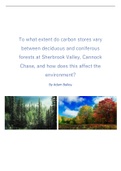Thesis
Example of A level AQA Geography NEA on carbon stores, nearly full marks
- Course
- Institution
This is my NEA Coursework that I submitted as part of my A level Geography. There aren't many examples for physical geography, so hopefully this will provide useful information and inspiration. I got nearly full marks, and feel it is well organised, labelled and referenced. Many many hours went in...
[Show more]



